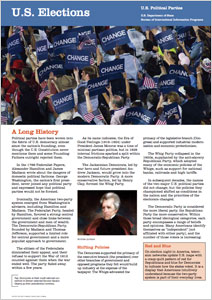A LONG HISTORY
Political parties have been woven into the fabric of U.S. democracy almost since the nation’s founding, even though the U.S. Constitution never mentions them and some Founding Fathers outright rejected them.
In the 1788 Federalist Papers, Alexander Hamilton and James Madison wrote about the dangers of domestic political factions. George Washington, the nation’s first president, never joined any political party and expressed hope that political parties would not be formed.
Ironically, the American two-party system emerged from Washington’s advisers, including Hamilton and Madison. The Federalist Party, headed by Hamilton, favored a strong central government and close links between the government and men of wealth. The Democratic-Republican Party, founded by Madison and Thomas Jefferson, supported a limited role for central government and a more populist approach to government.
The elitism of the Federalists diminished their appeal, and their refusal to support the War of 1812 counted against them when the war ended well. The party faded away within a few years.
As its name indicates, the Era of Good Feelings (1816–1824) under President James Monroe was a time of minimal partisan politics, but in 1828 internal frictions sparked a split within the Democratic-Republican Party.
The Jacksonian Democrats, led by war hero and future president Andrew Jackson, would grow into the modern Democratic Party. A more conservative faction, led by Henry Clay, formed the Whig Party.
SHIFTING POLICIES
The Democrats supported the primacy of the executive branch (the president) over other branches of government and opposed programs they felt would build up industry at the expense of the taxpayer. The Whigs advocated the primacy of the legislative branch (Congress) and supported industrial modernization and economic protectionism.
The Whig Party collapsed in the 1850s, supplanted by the anti-slavery Republican Party, which adopted many of the economic policies of the Whigs, such as support for national banks, railroads and high tariffs.
In subsequent decades, the names of the two major U.S. political parties did not change, but the policies they championed shifted as conditions in the nation and the priorities of the electorate changed.
The Democratic Party is considered the more liberal party, the Republican Party the more conservative. Within those broad ideological categories, each party encompasses a range of beliefs and opinions. Many Americans identify themselves as “independent” (not affiliated with either party), and the number of those voters is increasing.
TWO-PARTY SYSTEM
In 2008, the Democratic Party was the largest political party, with more than 74 million voters (37 percent of registered voters) claiming affiliation, according to the Pew Research Center. Barack Obama is the 15th Democrat to hold the office of the U.S. presidency.
George W. Bush was the 19th Republican to hold that office. In 2008, the Republican Party was the second largest U.S. political party, with nearly 56 million registered members, or approximately one-quarter of all registered voters.
A Democratic or Republican nominee has won every U.S. presidential election after 1848, and one of those parties has controlled the House of Representatives and the Senate since 1856. Other parties have won representation at national and state levels, but none has yet garnered sufficient support to form a voting bloc in Congress or mount a serious challenge for the U.S. presidency.
So-called “third parties” competing for the attention of U.S. voters include the Constitution Party, which advocates a return to what it believes were the original intentions of the Founding Fathers; the Green Party, which champions environmental stewardship and social justice; and the Libertarian Party, which supports a minimal role for government in the lives of citizens.
RED AND BLUE
On election night in America, television networks update U.S. maps with a crazy-quilt pattern of red for Republicans and blue for Democrats to indicate how the states voted. It is a display that Americans intuitively understand because the two-party system is part of their everyday lives.
